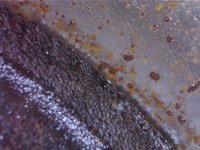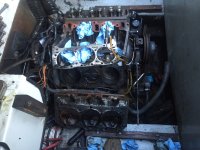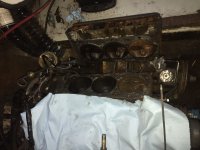Hi,
Found water in cylinders on one bank of a Merc 4.3 EFI, it was a few days between last running it (ran ok, and shutdown normally) and finding the water due too not turning over. I got the water out and flooded each cylinder with wd40 and left to soak for a couple of days, and now inspected with camera, clearly some surface rusting on cylinder wall:

I cant turn it over by hand with socket on crank so far (but I am not turning it as hard as I could as I dont want to sheer the belt pulley bolt, but turning it harder than it would normally take).
Do I flood it with more wd40 or oil and then try to turn it over with the starter and presuming it turns over do a compression check? I could take head off and try to clean cylinder walls up but that doesnt fix up piston rings etc and not much more I can do without lifting boat out, craning engine out and stripping it down, and if the cylinder walls are damaged then I am guessing it will need boring and oversize pistons anyway so does it do any harm to see if it can be turned over as is and if it does then after an oil change try to start it? Or if piston rings are corroded will it effect the oil in the cylinders and potentially do lots of harm?
The oil in the rockers is milky, oil in sump is not, so looks like water got in (presuming thru exhaust) at last shutdown (ill remove exhaust to check and fix before trying to start).
Basically it is middle of summer here in Australia and I am not sure whether to just try to get it runiing and if it works use it until winter, or if it even worked that will likly do more damage and have to bite the bullet and rebuild it out now (I have rebuilt engines before so not worried about doing it, just bad timing and limited parts availability at the moment here at short notice)
Thanks
Ants
Found water in cylinders on one bank of a Merc 4.3 EFI, it was a few days between last running it (ran ok, and shutdown normally) and finding the water due too not turning over. I got the water out and flooded each cylinder with wd40 and left to soak for a couple of days, and now inspected with camera, clearly some surface rusting on cylinder wall:

I cant turn it over by hand with socket on crank so far (but I am not turning it as hard as I could as I dont want to sheer the belt pulley bolt, but turning it harder than it would normally take).
Do I flood it with more wd40 or oil and then try to turn it over with the starter and presuming it turns over do a compression check? I could take head off and try to clean cylinder walls up but that doesnt fix up piston rings etc and not much more I can do without lifting boat out, craning engine out and stripping it down, and if the cylinder walls are damaged then I am guessing it will need boring and oversize pistons anyway so does it do any harm to see if it can be turned over as is and if it does then after an oil change try to start it? Or if piston rings are corroded will it effect the oil in the cylinders and potentially do lots of harm?
The oil in the rockers is milky, oil in sump is not, so looks like water got in (presuming thru exhaust) at last shutdown (ill remove exhaust to check and fix before trying to start).
Basically it is middle of summer here in Australia and I am not sure whether to just try to get it runiing and if it works use it until winter, or if it even worked that will likly do more damage and have to bite the bullet and rebuild it out now (I have rebuilt engines before so not worried about doing it, just bad timing and limited parts availability at the moment here at short notice)
Thanks
Ants



